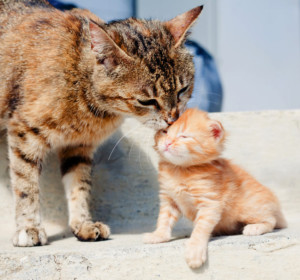Did you know that Spring is one of the busiest times of the year for animal adoptions? My theory is that humans are emerging from their winter hibernations, and realizing that they want a furry friend to share the beautiful, warm days with! Although there are probably a hundred reasons for this phenomenon, the reality is that many lucky pets are being whisked out of shelters, and into loving homes. This is SUCH a happy thing! But it can also be a very frightening and confusing time for these sweetie pies. Many cats in particular have difficult times adjusting to their new homes. I often tell new adopters: imagine going from a 3X2 kennel to a mansion. Even if that is not reality, that is what most cats perceive when they leave the shelter. That is crazy overwhelming! So, here are a few super simple tips to help your new feline ease into the good life.
- Start by confining your cat to a small area. Whether this be a bathroom, spare bedroom, or even a walk-in closet, this will be a lot less overwhelming than dumping a new cat into a larger space immediately. Though you may feel silly keeping a cat in your bathroom, trust me, they will thank you for it! Every kitty is different when it comes to their isolation time – some will be begging to come out the first night, and some will need 2 weeks. Be sure to listen to your cat’s behavior, and respect their fear.
- Introduce new things slowly. When your kitty is ready to leave their isolation room, open up the rest of your house as slowly as possible. If you have a lot of doors, close them for now. This will help your cat a) get acclimated to the space and b) keep track of their litter box. It’s much easier cleaning up messes when your cat only has minimal options for where to have them!
- If you have other animals, the name of the game is SLOW. Don’t introduce your new cat to other animals right away. Even if they have a history of living with cats or dogs, every animal is an individual! Keep them separated in different rooms, and begin by scent swapping. Put a sock on your hand and pet your resident animal, and then go pet your new cat with the same sock and vise versa. This will help the two animals get acclimated to the other’s scent (the animal version of reading a LinkedIn profile!). It’s also helpful to feed both animals on either side of the same door. This way, they can learn to associate the other’s presence with yummy yummy food. Always pair all interactions with positive things such as high-value treats and playtime. Slowly introduce the animals to each other, and if things don’t go so well, take a step back – things probably felt a bit rushed to them. Hopefully by repeating these steps, and slowly bringing them closer together over time, a true friendship will flourish!
- If your new kitty is having accidents, there may be a couple of different reasons. They might not like the type of litter you’ve chosen. If you picked scented, try unscented. If you picked clumping, try non-clumping, and so-on. They may also not approve of the type of litter box. If you bought a covered one, try an open one instead. They may also need more options. If you only have one box, get another and put it where the accidents seem to occur. The general rule of thumb is that owners should have one box per cat, plus one. Therefore, if you have 3 cats, you should have four boxes! It’s always better to start off with more, and take away if certain boxes remain unused.
- Try some calming tricks for shy cats. Some cats respond amazingly to Feliway spray or diffusers, which are essentially pheromone products to provide calming effects. Other cats LOVE classical music! Studies have shown that certain tones and notes stimulate feline neurons to calm the brain. Always pair your presence with something positive! If your kitty is hiding under the bed, lie down next to them and offer high value treats. Every cat is different, but you can try pureed baby food (in meat flavors with no additives), salmon flakes, a little shredded tuna, or tiny bits of shredded chicken. Over time, classical conditioning will work wonders on shy cats.
Trying a combination of all of these tricks should make for a well-adjusted, happy kitty, in love with their new home! It can take anywhere from days to months for cats to adjust to a new environment, and it really just depends on the individual cat. Keep in mind, if your cat is constantly having accidents outside the box, or showing other concerning signs, even after trying some of these tricks, it is necessary to consult your vet. There may be something physiological going on to explain the odd behavior. A healthy kitty is a happy kitty!
If you are one of the lucky humans bringing a new cat into your home, congratulations! Alexandria Pet Care would love to meet them and provide them (and you) with our excellent pet care services!







